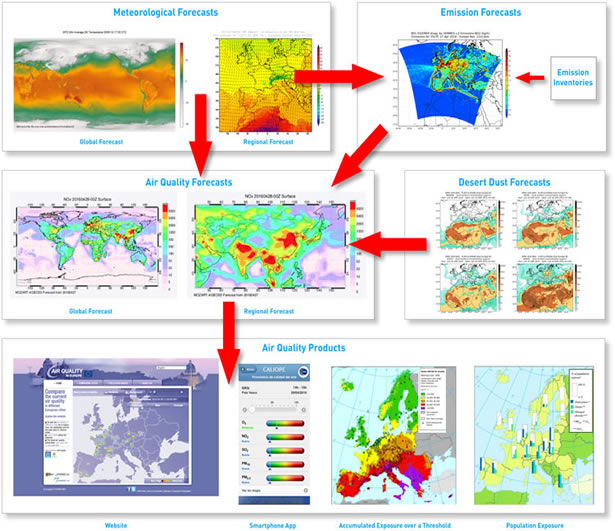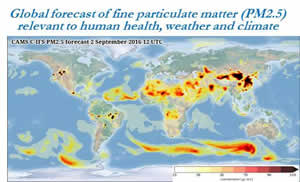Modelling Applications
Atmospheric composition and air quality modelling (Background)
Atmospheric composition matters to air quality and human health, ecosystem sustainability and biodiversity, visibility, weather and climate, agricultural food production, aviation safety, and many more. Atmospheric models, constrained by observations from ground-based, mobile platforms (e.g. aircrafts) and satellites, are critical in providing information on air quality on urban-regional-global scales- including the intercontinental transport of pollutants. Models can also be used to explore the future impact of natural changes and manmade emissions on atmospheric pollution to better inform policy-makers, businesses and citizens.
WMO Global Atmosphere Watch (WMO-GAW) Programme recognized (link to 2016 GAW Implementation Plan) the need for further developing up-to-date GAW products and services for a variety of user communities, and to support cross-cutting research activities concerning the forecasting of Atmospheric Composition Change and their induced environmental phenomena. Timely availability of observations to modelling activities is crucial.
GAW Scientific Advisory Group Modelling Applications: SAG-APPs
The GAW Scientific Advisory Group (SAG) on Modelling Applications (SAG-APPs) was established in 2016 by the WMO Congress to enhance the exchange between the GAW observational community, the modelling communities and other-end users of atmospheric composition data. Near-real-time data applications, such as air quality forecasting, need timely access to observations- in providing such services. Therefore one of the main objectives of this group is “To demonstrate the usefulness of exchanging chemical observational and modelling data in Near-real-time (NRT; i.e. hours-days) in support of monitoring and forecasting applications ”. The SAG-APPs members cover a broad range of disciplines, and represent a number research and user communities. SAG-APPs will promote current and envision future applications that make use of NRT data delivery on regional to global scales. SAG-APPs is a joint collaborative effort of GAW together with the World Weather Research Programme (WWRP) and the World Climate Research Programme (WCRP). This SAG also works closely with WIS/WIGOS- WMO’s Integrated Global Observation System. An important, already operational service, is the Copernicus Atmosphere Monitoring Service (CAMS; https://atmosphere.copernicus.eu/about-cams), providing near-real-time data analyses and forecasts on multiple atmospheric chemical constituents of relevance to air quality and other environmental issues at a global and regional scale. The Sand and Dust Storms Warning Advisory and Assessment system (SDS-WAS; http://www.wmo.int/sdswas) provides health-relevant information related to sand and dust storms. An schematic of potential GAW services is given in the figure below.

Schematic overview of potential GAW services
SAG APPs Objectives
The main objective of the SAG-Apps is to further develop a portfolio of modelling products and services related to atmospheric composition, and more specifically to demonstrate the usefulness of exchanging chemical observational data in Near-Real-Time in support of monitoring and forecasting applications. The rationale of forming the SAG-Apps is WMO’s strategy to provide advise and support to the meteorological institutions to broaden their services and products from the conventional weather forecast to services that include aspects of the atmospheric environment. The vision is that development of a portfolio of demonstration projects (i.e. designing concepts, endorsing initiatives, stimulating communities to develop these projects) will provide the necessary impetus to speed up the emergence and expansion of such services. These developments will not only benefit NRT applications but also provide a closer link to assessment activities, such as they are currently performed under the TF HTAP and partner organizations in the health (e.g., WHO), agriculture/vegetation (e.g. CLRTAP) and climate communities (e.g. CCMI).
SAG APPs specific Activities
SAG APPs activities are focused on developing products and activities around 6 themes that consider the use of observations for:
(1) Assessments (health, climate change, ecosystems)
(2) Improving emission inventories
(3) Further development of NRT modelling systems
(4) Observational data issues
(5) Developing scientific activities; i.e. the role of atmospheric composition in improving weather forecast
(6) Outreach activities.
Air Quality Products and Services by GAW SAG-APPs and Partners
WMO GAW liaises and promotes a number of demonstration activities, and services, including:
Global forecasts and assessments by Copernicus Atmosphere Monitoring Service (CAMS)
Sand and Dust Storms Warning Advisory and Assessment System (SDS-WAS)
Vegetation Fire and Smoke Pollution Warning Advisory and Assessment System (VFSP-WAS)
UNECE Task Force Hemispheric Transport Air Pollution (HTAP)
ICAP Global Aerosol Models Ensemble (link) and (link )
Integrated Global Greenhouse Gas Information System (IG3IS)
Total deposition maps by TAD SAG: A global assessment of precipitation chemistry and deposition
Downscaling to Urban Air Quality: GAW Urban Research Meteorology and Environment (GURME)
CAMS Model verification using GAW observations
Donwscaling of air quality forecasts by GAW partners (MarcoPolo) for China
and at the urban scale, e.g. for Beijing and other Chinese cities


Example of CAMS forecast of PM2.5 and ground-level ozone.
Publications
Training Materials and Best Practices for Chemical Weather/Air Quality Forecasting (ETR-26)
GAW Report No. 235 - Vegetation Fire and Smoke Pollution Warning and Advisory System (VFSP-WAS): Concept Note and Expert Recommendations
Coupled Chemistry-Meteorology/ Climate Modelling (CCMM): status and relevance for numerical weather prediction, atmospheric pollution and climate research (Geneva, Switzerland, 23-25 February 2015) ( WMO-No. 1172; GAW Report No. 226; WCRP Report No. 9/2016), 165 pp. May 2016, DOI: 10.13140/RG.2.1.4937.8169; web-link
Seamless Meteorology-Composition Models (SMCM): Challenges, gaps, needs and future directions. Chapter 12 in the WWOSC Book: Seamless Prediction of the Earth System: from Minutes to Months, (G Brunet, S Jones, PM Ruti Eds.), (WMO-No. 1156), (ISBN 978-92-63-11156-2), Geneva, pp. 213-233, 2015 Web-link
Airborne Dust: from R&D to Operational Forecast. 2013-2015 Activity Report of the SDS-WAS Regional Center for Northern Africa, Middle East and Europe.
UNEP, WMO, UNCCD (2016). Global Assessment of Sand and Dust Storms. United Nations Environment Programme, Nairobi. Web-link
SDS-WAS (2015). WMO Sand and Dust Storm Warning Advisory and Assessment System (SDS-WAS). Science and Implementation Plan 2015-2020
